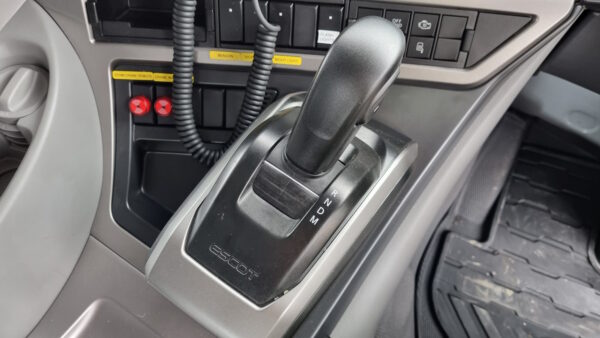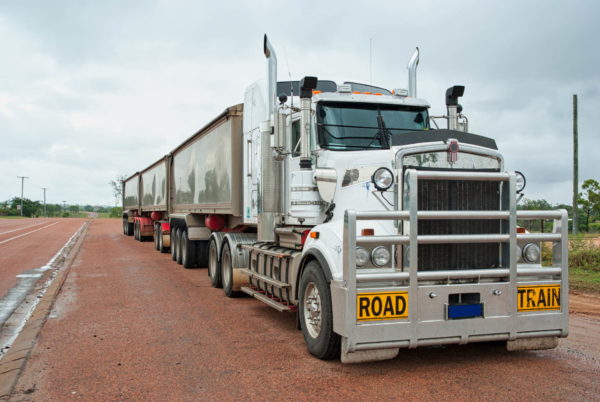A typical lorry, also known as a truck, commonly features a transmission system with gears designed to meet the demands of various driving conditions. Most lorries come equipped with a manual transmission that typically includes 5 to 18 gears.
However, the specific number of gears can vary based on the lorry’s make, model, and intended use. Modern lorries may also have automatic or semi-automatic transmissions, offering drivers a more user-friendly experience.
The number of gears in a lorry depends on factors such as the vehicle’s size, intended load capacity, and the type of transmission system it employs.
How do Lorry Transmissions Work?

Lorry transmissions serve as complex systems responsible for transmitting power from the engine to the wheels, allowing the vehicle to move forward or backward. The primary function is to regulate the torque and speed generated by the engine to meet the demands of different driving situations.
Essentially, the transmission acts as a mediator between the engine and the wheels, ensuring optimal power delivery.
The role of transmissions involves recognizing their ability to adapt to various driving conditions. Whether navigating steep inclines, accelerating on highways, or maneuvering through city traffic, the transmission adjusts the output to maximize efficiency and performance.
The Transmission System
The transmission system in lorries comprises several key components working in harmony to facilitate smooth and efficient power transfer.
Clutch Mechanism: In manual transmissions, lorries are equipped with a clutch that engages and disengages the connection between the engine and the transmission. This allows the driver to shift gears manually.
Gearbox: The gearbox is the heart of the transmission system, containing multiple gears with distinct ratios. Lorries may have a range of gears, each suited for specific driving conditions.
Differential: The differential distributes power to the wheels, enabling them to rotate at different speeds during turns. This ensures stability and prevents wheel slippage.
Shift Mechanism: Lorries with manual transmissions require a shift mechanism, allowing the driver to select the appropriate gear. Automatic and semi-automatic transmissions employ advanced systems that adjust gears based on driving conditions.
Fluids and Cooling: Transmission fluids play a crucial role in lubricating components and dissipating heat generated during operation, ensuring longevity and optimal performance.
Electronic Control Unit (ECU): Modern lorries often feature electronic control units that optimize gear selection based on factors such as speed, load, and driving conditions.
What is the Importance of Gears in Lorry Performance?
Gears in lorries are like tools – they help the truck handle hills, go fast on highways, and save fuel. Picking the right gear is key for saving money and being eco-friendly.
How Gears Contribute to Torque and Speed
Gears play a pivotal role in shaping the performance dynamics of lorries, influencing both torque and speed. Torque, the rotational force generated by the engine, varies with different gears.
Lower gears provide increased torque, ideal for tasks such as climbing steep inclines or hauling heavy loads. Higher gears, on the other hand, contribute to higher speeds, making them suitable for highway cruising.
The relationship between gears and torque is fundamental to lorry performance. Lower gears enhance the lorry’s ability to overcome resistance and handle challenging terrains, while higher gears optimize speed and efficiency on smoother surfaces.
Impact of Gear Selection on Fuel Efficiency
Efficient gear selection is a key determinant of fuel efficiency in lorries. Each gear has a distinct fuel consumption profile, and the choice of gear directly influences how the engine utilizes fuel.
Optimal RPM Range: Selecting the right gear ensures the engine operates within its optimal RPM (revolutions per minute) range. This prevents unnecessary fuel consumption and reduces wear on the engine.
Load Considerations: Matching the gear to the load is critical. Lower gears are efficient for heavy loads or steep inclines, but using them unnecessarily during lighter loads can lead to increased fuel consumption.
Driving Conditions: Adapting gear selection to driving conditions, such as city traffic or highway cruising, further enhances fuel efficiency. For example, lower gears are suitable for stop-and-go traffic, while higher gears are advantageous for sustained highway speeds.
Transmission Types: Automatic and semi-automatic transmissions incorporate advanced algorithms to optimize gear changes based on real-time driving conditions, contributing to better fuel economy.
What Are the Factors Affecting the Number of Gears?
The number of gears in a lorry depends on the type of lorry and its job. Lorries carrying heavy loads or driving on hilly terrain might have more gears for better control, while those in cities or on highways may have fewer gears for simplicity and fuel efficiency.
Types of Lorries and Their Specific Transmission Systems
Light-Duty Lorries
Lorries designed for lighter loads, such as delivery trucks, may have fewer gears in their transmission systems. This is because they don’t require the extensive gear range needed for heavy-duty tasks.
Heavy-Duty Lorries
Lorries built for heavy-duty applications, like long-haul transport or construction, often boast transmissions with a higher number of gears. This allows for better customization of power delivery to accommodate varying load demands.
Specialized Lorries
Certain lorries, like those used in off-road applications or specific industries, may have unique transmission systems tailored to their specialized needs, influencing the gear count.
Considerations for Load Capacity and Terrain
The load capacity a lorry is expected to handle, combined with the terrain it navigates, significantly influences the decision on the number of gears in its transmission.
Heavy Loads and Inclines
Lorries tasked with transporting heavy loads or traversing steep inclines benefit from transmissions with more gears. Additional gears provide finer control over power delivery, enhancing the lorry’s ability to handle challenging conditions.
City vs. Highway Driving
Lorries frequently operating in urban environments with frequent stops and starts may have transmissions optimized for lower speeds and quicker acceleration. Conversely, lorries primarily used on highways might feature transmissions geared towards sustained higher speeds.
Fuel Efficiency Concerns
Considerations for fuel efficiency play a role in determining the number of gears. Lorries focused on fuel savings may incorporate transmissions with a carefully calibrated gear range to optimize efficiency across different driving scenarios.
Technology and Automation
Advances in transmission technology, including automated and semi-automated systems, contribute to adaptability in various conditions. These technologies can adjust gear ratios dynamically, enhancing the lorry’s overall performance.
How Many Gears Does A Lorry Typically Have?
| Gear Count Range | Description |
| Low Gear Counts | Lorries with low gear counts (e.g., 5-8 gears) are used for local deliveries and short-haul trips, offering simplicity for urban driving with frequent stops and starts. |
| Moderate Gear Counts | Lorries featuring moderate gear counts (e.g., 9-12 gears) are ideal for general-purpose and regional transport. This range provides balanced performance across diverse driving conditions and terrains. |
| High Gear Counts | Lorries with high gear counts (e.g., 13 gears and above) are suited for long-haul and heavy-duty tasks, delivering precise control over power delivery. This range is common in applications like climbing steep grades or hauling heavy loads. |
What Are The Advantages and Disadvantages of Different Gear Counts?

Lorries with fewer gears (e.g., 5-8) are simpler to operate and potentially more cost-effective, but they may face limitations in handling challenging terrains.
On the other hand, Lorries with more gears (e.g., 13 and above) offer versatility and better performance, but they can be more complex and potentially pricier to maintain.
Pros and Cons of Lorries with Fewer Gears
Lorries with fewer gears, typically in the lower gear count range, offer certain advantages and disadvantages:
Pros:
- Simplicity: Lorries with fewer gears are often simpler to operate, making them user-friendly for drivers, especially in urban environments with frequent stops and starts.
- Maintenance: Fewer gears can result in a simpler transmission system, potentially reducing maintenance costs and complexity.
- Cost: Lorries with fewer gears may be less expensive to manufacture and maintain.
Cons
- Limited Performance: Lorries with fewer gears may face limitations in handling challenging terrains, heavy loads, or achieving optimal fuel efficiency in varied driving conditions.
- Fuel Efficiency: The simplicity of fewer gears might lead to suboptimal fuel efficiency, especially during highway driving where a broader range of gears could enhance performance.
Pros and Cons of Lorries with More Gears
Lorries with more gears, typically in the higher gear count range, come with their own set of advantages and disadvantages
Pros
- Versatility: Lorries with more gears can adapt to a wider range of driving conditions, providing versatility in handling various terrains, loads, and driving scenarios.
- Performance: More gears allow for finer control over power delivery, enabling efficient climbing of steep grades, improved acceleration, and optimized fuel efficiency.
- Specialized Applications: Lorries with higher gear counts are well-suited for specialized applications, such as long-haul transport and heavy-duty tasks.
Cons
- Complexity: More gears can result in a more complex transmission system, potentially increasing maintenance requirements and costs.
- Learning Curve: Lorries with higher gear counts may have a steeper learning curve for drivers, requiring familiarity with the optimal use of multiple gears for various conditions.
- Cost: Lorries with more gears may be costlier to manufacture and maintain due to the complexity of the transmission system.
FAQ
How many gears are in an 18 wheeler?
An 18-wheeler, commonly known as a semi-truck or tractor-trailer, typically has a transmission system with 10 to 18 gears, allowing for varied power delivery to navigate different driving conditions.
Do trucks have 14 gears?
Yes, some trucks are equipped with 14 gears in their transmission systems. The specific number of gears can vary based on the truck’s make, model, and intended use.
Do trucks have 10 gears?
Yes, many trucks, especially those used for regional or long-haul transportation, commonly feature 10 gears in their transmission systems, providing a balanced performance across various driving conditions.
How many gears does a manual truck have?
Manual trucks can have varying gear counts, but they often range from 9 to 18 gears, offering drivers manual control over gear selection for different driving scenarios.
Do trucks have 12 gears?
Yes, trucks can have 12 gears in their transmission systems. This gear count is commonly found in both manual and automatic transmissions, catering to a range of applications.
How many gears does a Scania truck have?
Scania trucks typically have transmission systems with a range of gears, commonly falling between 8 and 14 gears. The specific number depends on the model and configuration of the Scania truck.
What’s the most gears in a lorry?
The number of gears in a lorry can vary, but some heavy-duty lorries, especially those designed for long-haul transport and specialized applications, may have transmission systems with 18 gears or more.
How many gears does a Volvo truck have?
Volvo trucks are known for their diverse range of models and applications, and their transmission systems usually offer between 12 and 18 gears, providing versatility for different driving conditions.
How many gears does a UK lorry have?
UK lorries, similar to lorries in other regions, can have varying gear counts. Transmission systems in UK lorries typically range from 8 to 18 gears, depending on the specific make, model, and intended use of the lorry.
Final words
To conclude the journey, the number of gears in a lorry is a crucial aspect that impacts its performance in various ways. Whether it’s the simplicity of fewer gears for city driving or the versatility of more gears for heavy-duty tasks, this factor helps drivers and operators make informed decisions.
Ultimately, the right gear count ensures efficiency, fuel savings, and optimal performance, making lorries reliable and adaptable for their specific roles on the road.

